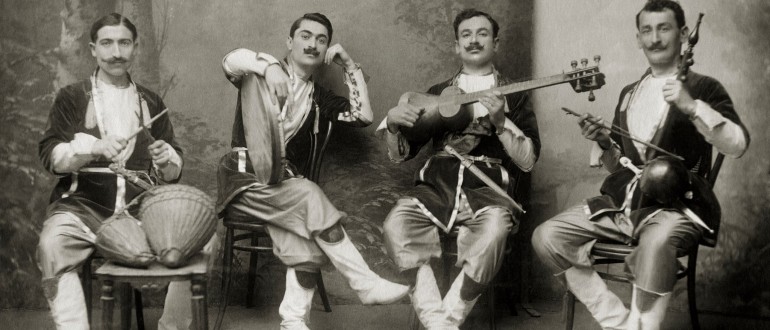Georgian urban musical art is an important part of national musical folklore. This artistically independent layer was born as a result of the synthesis of different cultural traditions and survived up to the 20th century in two major branches – Eastern (one-voiced) and Western (multi-voiced) urban folklore.
The interference of Eastern tunes in Georgia started in the 16th-17th centuries. The Eastern branch of urban folklore is also called Ashugh art. It was born in Samstkhe-Javakheti and Kartli-Kakheti as a result of the Muslim settlement. The popularity of Ashugh art is associated with the names of Sayatnova and Besiki – poets and musicians at the court of King Erekle II in the 18 th century. Sayatnova, an Armenian by origin, spent almost all his life in Georgia. He wrote poems in three languages – Georgian, Armenian and Persian and sang them in Persian melodies. Besiki, a Georgian poet, could perfectly play the saz and tar. He introduced the forms typical of oriental poetry – baiati and mukhambazi, into Georgian poetry. These forms gained a foothold in the 19 th century Tbilisi and laid foundation to the Tbilisi musical folklore. Eastern art was of syncretic character, because the elements of music, poetry and theatre were organically merged in it. Ashughs were the people gifted with the talent of poetry and music, and the ability of improvisation. They occupied a distinguished place in the cultural life of Tbilisi. The ashughs Satara, Saginashvili, Shamchi-Melko, Evangula, Chipr-Dalakishvili, Hazira, Yetim Gurji and others were especially popular.
Lyrical-intimate, eulogic, patriotic and social themes are leading in their creative works. Among the most famous samples of Tbilisi folklore are Akhal Aghnago Sulo, Mukhambazi, Akh Mtvarev, Avar-Avar, Patara Bichi, Kekeljan, Shenda Sheqramdis, etc.
Georgian urban one-voiced songs bear a clearly expressed Eastern colouring. They are characterized by melismatic ornamentation of basic pitches, harmonic major and minor descending tetra-chord with augmented seconds, alternation of meter, etc.
Eastern instruments represent organic part of the urban folklore’s eastern branch. Generally, singing was accompanied by non-Georgian instruments duduki, zurna, saz and others. The ensemble of eastern instruments was called dasta.
This flow of urban folklore was broadly used by the classics of Georgian music, especially in romances and operatic lyrical arias.
Urban folklore of the western manner is a phenomenon of later times; it became popular in the second half of the 19th century and its origin is associated with the activity of the Italian opera group in Tbilisi from 1851. The synthesis of Neapolitan songs, Italian operatic arias, Russian romances, students’ songs and Georgian traditional multi-voiced singing created a new type of polyphony, based on the major-minor functionality. These songs are performed by two or three voices with the accompaniment of a guitar. National colouring together with the intonational structure is also enriched by specific glossolalia. Many urban multi-voiced songs of this branch are closely connected with Georgian poetry. They were especially widespread in the towns of Kutaisi and Zestaponi in Imereti. The most popular songs are Tsitsinatela, Aghmart-Aghmart, Santelivit Chavkrebi, Morbis Aragvi, Mesmis-Mesmis and others. Multi-voiced urban song, in its turn, had great impact on the lyrical nature of Georgian professional music in the 1940s.





